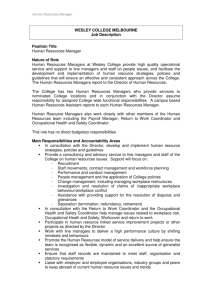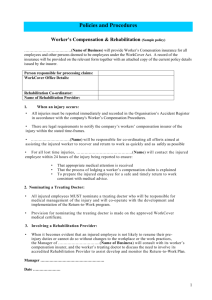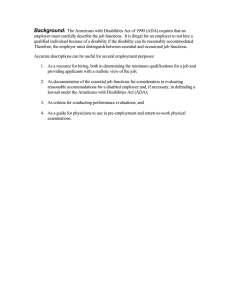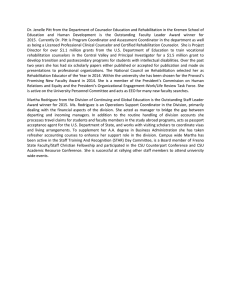OCCUPATIONAL REHABILITATION PROGRAM
advertisement
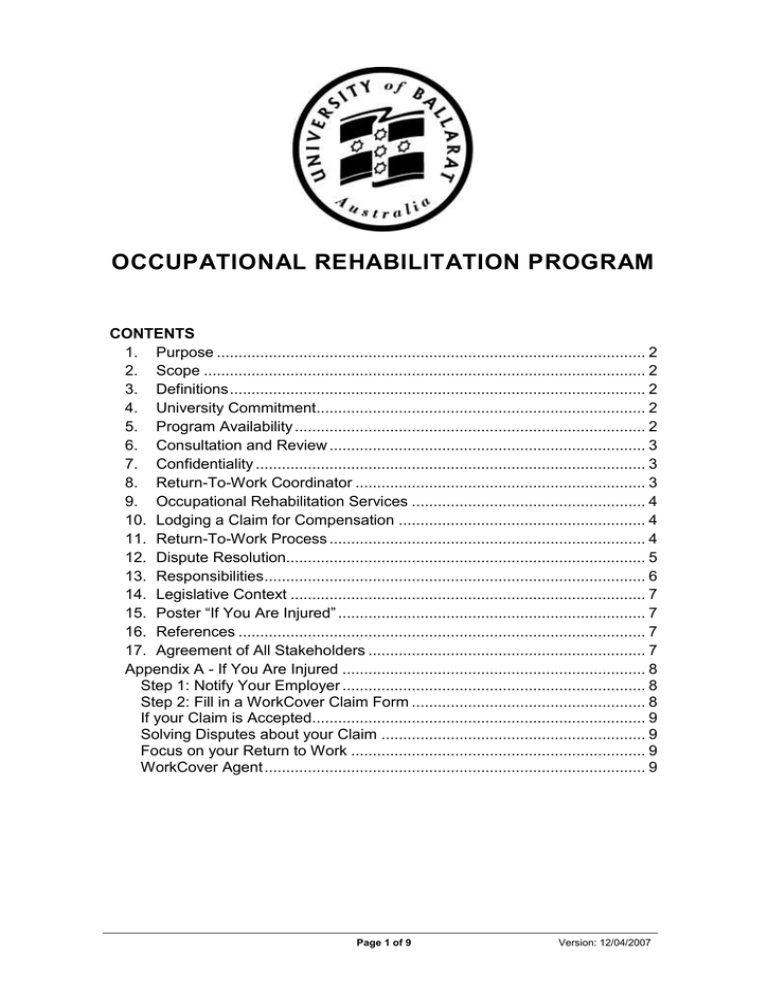
OCCUPATIONAL REHABILITATION PROGRAM
CONTENTS
1. Purpose ................................................................................................... 2
2. Scope ...................................................................................................... 2
3. Definitions ................................................................................................ 2
4. University Commitment............................................................................ 2
5. Program Availability ................................................................................. 2
6. Consultation and Review ......................................................................... 3
7. Confidentiality .......................................................................................... 3
8. Return-To-Work Coordinator ................................................................... 3
9. Occupational Rehabilitation Services ...................................................... 4
10. Lodging a Claim for Compensation ......................................................... 4
11. Return-To-Work Process ......................................................................... 4
12. Dispute Resolution................................................................................... 5
13. Responsibilities ........................................................................................ 6
14. Legislative Context .................................................................................. 7
15. Poster “If You Are Injured” ....................................................................... 7
16. References .............................................................................................. 7
17. Agreement of All Stakeholders ................................................................ 7
Appendix A - If You Are Injured ...................................................................... 8
Step 1: Notify Your Employer ...................................................................... 8
Step 2: Fill in a WorkCover Claim Form ...................................................... 8
If your Claim is Accepted............................................................................. 9
Solving Disputes about your Claim ............................................................. 9
Focus on your Return to Work .................................................................... 9
WorkCover Agent ........................................................................................ 9
Page 1 of 9
Version: 12/04/2007
University of Ballarat - Occupational Rehabilitation Program
1. Purpose
To affirm the commitment of the University of Ballarat to the rehabilitation of employees
to normal duties, following work-related injuries.
To advise the University on the allocation of resources to ensure the successful
implementation of specific measures to meet the intent of the program.
To assign responsibilities in relation to the reporting of injuries, the rehabilitation and
the Return-To-Work of employees who have incurred a work-related injury.
2. Scope
The following program applies to all paid employees of the University.
3. Definitions
"Occupational rehabilitation” - a managed process aimed at maintaining employees in,
or returning them to, suitable employment following a work-related injury. It assists
employees to maintain or recover, as fully as possible, their physical, psychological,
vocational, social and economic status by returning to their pre-injury job as early as
possible. It involves early intervention with appropriate, adequate and timely services
based on assessed needs.
"Work-related injury” - any physical or mental disease or injury contracted by an
employee in the course of the employee's employment, whether at or away from the
place of employment, and to which the employment was a significant contributing
factor.
It includes the recurrence, aggravation, acceleration, exacerbation or
deterioration of any pre-existing injury or disease, where the employee's employment
was a significant contributing factor.
"University" - means the University of Ballarat.
"Claimant" - means an employee of the University who has submitted a workers
compensation (WorkCover) claim.
4. University Commitment
The University of Ballarat is committed to assist employees who have incurred a workrelated injury to remain at work or return to work as soon as medically advisable by:
Commencing the Return-To-Work process as soon as possible after an injury,
consistent with medical advice.
Providing treatment, Return-To-Work activities and any reasonably necessary
occupational rehabilitation service(s) as early as is possible, with regard to the
individual situation.
Offering suitable employment, including modified or alternative duties, consistent
with medical opinion, to assist injured employees remain at work or Return-ToWork at the earliest opportunity.
Establishing an individual Return-To-Work Plan with any employee who has no
current work capacity for 20 calendar days or more. The plan will be established in
conjunction with the medical practitioner, employee, supervisor and the University's
Return-To-Work Coordinator. Plans will be reviewed on alteration to WorkCover
Certificates of Capacity.
5. Program Availability
The Occupational Rehabilitation Program is available on the University of Ballarat's
website at www.ballarat.edu.au/aasp/staff/ohs/Rehab.doc. Copies of the program are
Page 2 of 9
Version: 12/04/2007
University of Ballarat - Occupational Rehabilitation Program
included in the University’s New Starters’ Kits and available by phoning the WorkCover
Coordinator’s Office on 9512.
6. Consultation and Review
The University of Ballarat will consult with relevant stakeholders in regard to the
Occupational Rehabilitation Program, including the University's Occupational Health
and Safety Representatives and management. Individual employees may have input
by approaching the Return-To-Work Coordinator or your local health and safety
representatives.
The Occupational Rehabilitation Program will be reviewed formally, on an annual basis,
at the beginning of each calendar year, between occupational health and safety
representatives, occupational health & safety staff, Return-To-Work Coordinator and
management.
7. Confidentiality
Confidentiality of information obtained about the employee during their Return-To-Work
or while undertaking occupational rehabilitation services will be maintained. However,
claimants should note that in the review process details of the claim under examination
will be verified with relevant parties. These may include independent medical
assessors, insurance investigators, managers, supervisors and colleagues.
When a WorkCover claim involves allegations against one or several University
employees, the nature of the allegations and the identity of the claimant will be
disclosed to the staff member(s) against whom the allegations are made. In such
cases, the University's Return-To-Work Coordinator will advise the claimant of this
process of disclosure upon receiving the claim. The Return-To-Work Coordinator will
also inform the claimant of alternative grievance resolution processes in place within
the University.
If a Complainant lodges a WorkCover claim that involves allegations of bullying, the
relevant portion of the WorkCover claim will be taken to be a written complaint in
accordance with Part4D Formal Procedure of the Bullying Prevention and Management
Procedure.
8. Return-To-Work Coordinator
The nominated Return-To-Work Coordinator for the University of Ballarat is Kelley
Jones. Kelley is located in the Human Resources Department, 1st floor, T Building, Mt
Helen campus. Her extension number is 9512.
The duties of the Return-To-Work Coordinator by law include:
Assisting injured employees, where prudent and practicable, to remain at or ReturnTo-Work as soon as possible after injury.
Liaise with any parties involved in the occupational rehabilitation of, or provision of
medical or hospital services to, the injured employee.
Monitoring the progress of the injured employee's capacity to work.
Ensuring that, where reasonably necessary, the injured employee is given access
to occupational rehabilitation services.
Taking suitable steps to prevent recurrence or aggravation of the relevant injury
upon the injured employee's Return-To-Work.
Assisting in meeting the legal requirements regarding risk management,
occupational rehabilitation and Return-To-Work.
Page 3 of 9
Version: 12/04/2007
University of Ballarat - Occupational Rehabilitation Program
Processing WorkCover claims in accordance with legislation and insurer service
agreements.
Maintaining the confidentiality of the personal and medical information of claimants
obtained in connection with a compensation claim (see 7. Confidentiality clause).
The Return-To-Work Coordinator at the University of Ballarat reports to the Director,
Human Resources
Suitable training is made available to the Return-To-Work Coordinator to ensure up-todate best management practices are available to injured employees.
9. Occupational Rehabilitation Services
Professional occupational rehabilitation services will be engaged, as individual cases
require. The University of Ballarat is committed to professional case management and
will use only Victorian WorkCover Authority accredited rehabilitation professionals.
Employees who require occupational rehabilitation services will be given the details of
three accredited service providers in the Ballarat and Western Districts, from which to
make their selection.
Employees who are not referred to an approved rehabilitation provider may request the
service. Approval must be sought from the University's WorkCover agent.
10.
Lodging a Claim for Compensation
Any employee who wishes to lodge a claim for compensation following a work-related
injury can do so by phoning the Return-To-Work Coordinator on (5327) 9512. A valid
WorkCover Employee's Claim Form marked "Private & Confidential" should be sent to:
WorkCover Coordinator, University of Ballarat, PO Box 663, Ballarat 3353.
The Return-To-Work Coordinator will forward claims to the University's WorkCover
agent within 10 days. Incorrect or incomplete claims will be returned to the claimant
within 14 days with a written explanation and a notice that the claim will only be
deemed received when completed and valid.
WorkCover agents have 28 days from the date they receive the claim, to accept or
deny liability for claims for weekly compensation for time lost, or 60 days for medical
expenses only claims. Sick leave or annual leave may be paid to the claimant upon
application to the Return-To-Work Coordinator, until determination of the claim by the
University’s WorkCover agent. If the agent accepts liability, payments for time off will
comply with all applicable requirements contained in relevant legislation and awards,
and any sick or annual leave taken will be re-credited to leave balances.
Claimants should note in particular, that under applicable award conditions the
University of Ballarat makes up the shortfall between the compensation payments
made by the WorkCover agent and the claimant's pre-injury average weekly earnings,
for a period of 52 aggregate weeks of incapacity to work.
Claimants on long periods of work incapacity should seek advice regarding the
disability benefit arrangements under their superannuation funds. It should also be
noted that, after a period of 52 aggregate weeks of incapacity to work, make-up pay
ceases and employees' entitlements are reduced to insurance payments only. At this
time superannuation contributions and payout may be adversely affected. Claimants
are strongly advised to speak directly with their superannuation fund to understand
their entitlement.
11.
Return-To-Work Process
The University of Ballarat is committed to keeping injured employees at work, and/or
returning injured employees to work as soon as certified medically fit. Injured
employees are expected to participate actively in the Return-To-Work process.
Page 4 of 9
Version: 12/04/2007
University of Ballarat - Occupational Rehabilitation Program
Partial incapacity to work - the Return-To-Work Coordinator intervenes early to
maintain the injured employee in suitable employment, consistent with medical advice.
Temporary complete incapacity to work - the Return-To-Work Coordinator
intervenes early to return the injured employee to suitable employment, consistent with
medical advice.
The Return-To-Work Coordinator's intervention is conducted in close liaison with all
parties:
Injured employee and family (this may entail home contact)
Supervisor and/or Manager
Treating medical practitioner(s) and rehabilitation service providers (if applicable)
WorkCover agent.
Based on this consultation, an offer of suitable employment will be made to injured
employees. (Within 12 months of when you became unable to do your normal work,
the University must offer you suitable employment as soon as your doctor says you can
work. If you are able to work and unreasonably refuse suitable employment, benefits
may cease.) An offer of suitable employment may include one or several of the
following options, depending on medical advice:
Modified or alternative duties.
Restricted hours of work.
Graduated hours of work.
Workplace modifications.
In some circumstances (eg where 20 calendar days have been lost), the Return-ToWork Coordinator will prepare and supply a formal Return-To-Work Plan with an Offer
of Suitable Employment. All Return-To-Work Plans will comply with the standards set
down by the Victorian WorkCover Authority. A Return-To-Work Plan is signed by all
parties to ensure all parties participate, agree and resolve to put the plan into action. If
you unreasonably refuse to take part in rehabilitation or training, or if you are not
seeking suitable employment, your benefits may cease. Participation in a Return-ToWork Plan will not, of itself, prejudice an injured employee.
The Return-To-Work Plan will be modified as required on the receipt of a WorkCover
Certificate of Capacity with a change in work capacity. Claimants should note that the
hours of work and duties prescribed in the Return-To-Work Plan must be adhered to.
Medical appointments should be scheduled outside work hours, especially if restricted
hours are being worked.
The WorkCover agent may refer claimants to an independent medical practitioner, but
not more than once every three months. Employees may be referred to an approved
occupational rehabilitation provider to assist in their recovery, and/or the Return-ToWork process.
12.
Dispute Resolution
Injured employees have three avenues of dispute resolution open to them. If you
believe your claim for compensation has not been handled correctly, talk to your
employer or your WorkCover agent. You can also ring the WorkCover Advisory
Service on 1800 136 089 for free advice. If you are still not satisfied, you can ask for
conciliation. Conciliation can help to resolve your dispute without the need to go to
court. Ring the Accident Compensation Conciliation Service on 1800 810 071 for more
information. The WorkCover Conciliation Service is an independent body that
conciliates between employees, employers and insurance agents.
The University of Ballarat has procedures in place to ensure fair and consistent
treatment of staff grievances. These procedures are designed, in the first instance, to
allow members of staff to resolve matters of dissatisfaction through an informal
Page 5 of 9
Version: 12/04/2007
University of Ballarat - Occupational Rehabilitation Program
process, progressing to formal procedures if resolution cannot be achieved. Staff
Grievance Procedures are specified in a Council policy statement available from the
relevant senior manager or from the Policies section of the University's website
www.ballarat.edu.au/vco/legal/Policies/index.shtml.
Mediation can be, and is, used in instances of conflict between injured employees and
colleagues, supervisors and/or managers. An independent mediator will be appointed
from one of the accredited occupational rehabilitation services to meet with all parties
in an effort to resolve conflict, and to enable maintenance at work and/or the ReturnTo-Work process to go ahead more effectively. Injured employees may have a support
person present during mediation, as long as this person is not a qualified solicitor. All
matters dealt with during mediation will be confidential (see 10. Confidentiality
clause).
13.
Responsibilities
The Vice-Chancellor of the University is ultimately responsible for the program, and is
accountable for the performance of the University in relation to this program.
All employees of the University are responsible for the prompt reporting of work-related
injuries, in accordance with University procedures.
The work colleagues and supervisors/managers of employees who have incurred a
work-related injury must support them in their efforts to return to work.
The Director Human Resources and Return-To-Work Coordinator are jointly
responsible for:
Informing the University community of the existence and outlines of the program,
related procedures and Return-To-Work arrangements.
Conducting training sessions to enable Managers to fulfil the role assigned to them
by this program.
Providing rehabilitation services within the University.
Supervisors & Managers are responsible for:
Attending training sessions related to the implementation of this program.
Publicising, promoting and enforcing the program and related procedures among
the staff they supervise (including new staff).
Complying with the program.
Promoting the prompt reporting of incidents and injuries in accordance with
University procedures.
Finding suitable duties that promote the successful Return-To-Work of their injured
employees to pre-injury duties, in consultation with the Return-To-Work
Coordinator.
Establishing a work environment that promotes recovery for employees on
rehabilitation.
Monitoring that employees on rehabilitation comply with the terms of their ReturnTo-Work Plan.
Encouraging employees on rehabilitation to report difficulties as they arise.
Liaising with the Return-To-Work Coordinator.
The University Health and Safety Policy Committee is responsible for monitoring the
performance of all Schools and Sections in relation to the program.
Injured Employees are responsible for:
The early reporting of their injury(ies).
Actively participating in the Return-To-Work process.
Reporting problems and difficulties as they arise.
Page 6 of 9
Version: 12/04/2007
University of Ballarat - Occupational Rehabilitation Program
Complying with treatment offered by accredited rehabilitation providers.
14.
Legislative Context
Accident Compensation Act 1985 (Victoria) and subordinate regulations.
15.
Poster “If You Are Injured”
It is a legal requirement that the poster "If You Are Injured" produced by the Victorian
WorkCover Authority is displayed in all Victorian workplaces. The return-To-Work
Coordinator makes posters available to all campuses, and further copies can be sent
on request. The text of the poster is reproduced in Appendix A of this document.
16.
References
Guidance Note for the Best Practice Rehabilitation Management of Occupational
Injuries and Diseases [NOHSC:3021 (1995)]
The Return-To-Work Guide for Victorian Employers [Victorian WorkCover Authority
(2002)]
17.
Agreement of All Stakeholders
The foregoing is the University of Ballarat's Occupational Rehabilitation Program,
incorporating the Return-To-Work process and Return-To-Work Coordinator details as
prescribed by the Victorian WorkCover Authority.
The Program has been determined in consultation with the University's management
and Occupational Health and Safety Representatives.
Page 7 of 9
Version: 12/04/2007
University of Ballarat - Occupational Rehabilitation Program
Appendix A - If You Are Injured
Note: It is a legal requirement that the following text be displayed in all Victorian
workplaces. The relevant procedures of the University of Ballarat comply with
these requirements. You are therefore requested to comply with the University
procedures on Incident Reporting and the Rehabilitation Program, which will
guarantee compliance with the WorkCover requirements.
Step 1: Seek medical treatment
The most important thing to do if you have a work-related injury or illness is to seek
appropriate medical treatment. You can choose which medical practitioner or healthcare
professional you visit.
Step 2: Tell your employer
You should report any work-related injury or illness to your employer as soon as possible,
and in any event, you must report it within 30 days of becoming aware of it.
The easiest way to notify your employer is to record the details of your injury or illness in
the Register of Injuries {Injury Report at UB}. If you are unable to notify your employer,
someone else can give notice on your behalf within the 30-day limit. If you don’t notify your
employer in writing you may not be entitled to compensation.
Step 3: Fill in a claim form
You must complete a WorkCover Worker’s Claim Form if you require time off work or
medical treatment because of a work-related injury or illness and want to claim WorkCover
Entitlements…. {The Return-To-Work Coordinator has forms, extension 9512.}
If you are unable to perform your normal duties you will need a WorkCover Certificate of
Capacity from your medical practitioner.
For more information on making a claim, get the How to Make a WorkCover Claim
brochure at www.workcover.vic.gov.au or call the WorkCover Advisory Service on freecall
1800 136 089 or (03) 9641 1444.
Step 4: Lodge the Claim
Give the completed WorkCover Worker’s Claim Form and the WorkCover Certificate of
Capacity to your employer as soon as you can.
By law, your employer can’t refuse to receive your WorkCover claim, and can’t dismiss you
for making one.
If you want to make sure that your Agent is aware of your claim, you can send a copy of the
completed claim form and any WorkCover Certificates of Capacity to your Agent or the
Victorian WorkCover Authority once you have given the original documents to your
employer. You can use the Early Notification Copy of the claim form to do this.
If your claim is for weekly payments, your employer is required to forward these documents
to your Agent within 10 days of receiving them, and the Agent then has up to 28 days to
accept or reject your claim.
Page 8 of 9
Version: 12/04/2007
University of Ballarat - Occupational Rehabilitation Program
If your Claim is Accepted
You will be entitled to payment for;
reasonable medical and like costs, and
if you need time off work, your Agent will assess your entitlement to weekly payments.
Weekly payments are determined by a percentage of your pre-injury average weekly
earnings (PIAWE) capped at a maximum rate. The first 26 weeks of weekly payments
may include overtime and shift allowances.
The amount you receive will depend on your pre-injury average weekly earnings and:
How long you have been receiving weekly benefits;
The extent of your current work capacity; and
Whether you have current weekly earnings.
For information on how your claim will be managed, you should contact your WorkCover
agent.
If your injury or disease results in permanent impairment, you may also be entitled to a
lump sum impairment benefit.
If your injury occurred on or after 20 October 1999, you may also be able to sue for
common law damages.
Further information on impairment and common law benefits is on the VWA website or in
the publication ‘All about WorkCover for Workers’, available from VWA publications on (03)
9641 1333.
If a worker dies as a result of a work-related injury or disease, the dependent spouse(s)
and children will be entitled to lump sum payments.
Solving Disputes about your Claim
If you disagree with a decision relating to your claim, talk to your employer, your Agent or
call the WorkCover Advisory Service on freecall 1800 136 089 or (03) 9641 1444.
If you are still not satisfied, you can ask for conciliation to help you to resolve your dispute
without the need to go to court. Call the accident Australian Compensation Conciliation
Service on 1800 635 960 for more information (www.conciliation.vic.gov.au)
Focus on your Return to Work
Getting back to work after a work-related injury or illness is an important step. In many
cases, it helps both your physical and psychological recovery. Job satisfaction, social
contact, and being part of a team are some of the things you might miss when you’re not at
work.
Your employer might be required to prepare a return-to-work plan for you, in conjunction
with your treating healthcare professional. This might mean you stay at work during your
recovery on modified duties. Focus on your goal of returning to work as soon as possible
and talk regularly with your employer and healthcare professional to keep them updated on
your progress.
For more information on returning to work, talk to your Agent.
WorkCover Agent
The University is insured with Allianz Australia Workers Compensation (Vic) Ltd, Suite 1
Level 2, 117 Myers Street, Geelong 3220, telephone 03 5226 1000.
Page 9 of 9
Version: 12/04/2007
